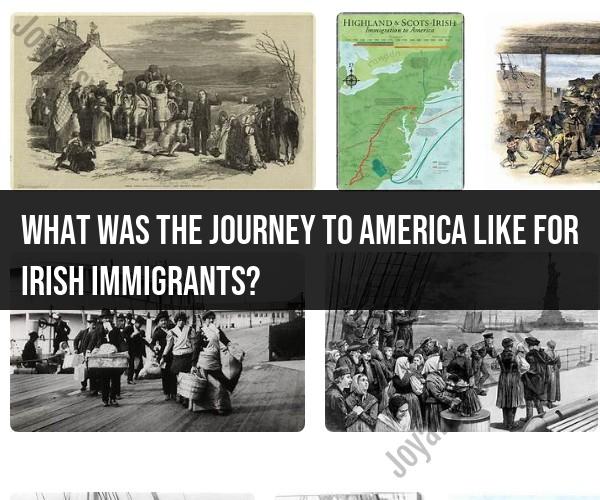What was the journey to America like for Irish immigrants?
The journey to America for Irish immigrants during the 19th and early 20th centuries was often arduous, perilous, and marked by numerous challenges. Irish immigration to the United States occurred in several waves, with the most significant wave happening during and after the Great Famine (1845-1852). Here are some historical insights into what the journey was like for Irish immigrants:
Famine Conditions in Ireland: Many Irish immigrants left their homeland due to dire circumstances caused by the Great Famine. The failure of the potato crop, the primary food source for most Irish, led to widespread famine, poverty, and death. People faced starvation, disease, and evictions from their homes.
Initial Departure: The journey began with the departure from Ireland, often from ports such as Dublin, Cork, or Belfast. Families and individuals typically traveled on foot, by horse-drawn cart, or by train to reach the departure ports.
Voyage Across the Atlantic: Most Irish immigrants traveled to the United States by ship, and the journey across the Atlantic Ocean could take several weeks. Many Irish immigrants sailed on overcrowded and often unseaworthy vessels, sometimes referred to as "coffin ships." These ships were notorious for poor conditions, lack of sanitation, and disease outbreaks.
Poor Conditions Onboard: Conditions during the voyage were often deplorable. Passengers faced cramped quarters, inadequate food and water, and unsanitary conditions. Diseases such as cholera and typhus could spread rapidly among passengers, leading to illness and death.
Loss of Life: Tragically, many Irish immigrants did not survive the journey. High mortality rates were common, particularly among the most vulnerable, including infants, the elderly, and those weakened by hunger and disease.
Ellis Island and Other Ports: Upon arrival in the United States, immigrants were processed at various ports of entry. Ellis Island in New York Harbor was a well-known entry point for many immigrants, including the Irish. Here, immigrants underwent medical examinations, interviews, and administrative procedures to determine their eligibility for entry.
Challenges and Discrimination: Irish immigrants faced challenges and discrimination in the United States. They often encountered prejudice and hostility, particularly in the job market. Many Irish immigrants worked in difficult and dangerous jobs, such as building railroads or working in factories.
Settlement and Community Building: Despite the hardships, Irish immigrants formed close-knit communities in cities and towns across the United States. They built churches, schools, and social organizations, preserving their cultural heritage and supporting one another.
Contributions to American Society: Over time, Irish immigrants and their descendants made significant contributions to American society, including in politics, labor movements, the military, and the arts. They played a crucial role in shaping the cultural fabric of the United States.
The journey to America for Irish immigrants was marked by immense challenges and sacrifices, but it also represented hope for a better life and opportunities for future generations. Their experiences are an important part of American history and the broader story of immigration to the United States.
The Irish immigrant experience in America was one of both challenges and triumphs. Irish immigrants faced many hardships, including discrimination, poverty, and disease. However, they also made significant contributions to American society.
The Journey to America
The majority of Irish immigrants came to America in the mid-19th century, during the Great Famine. The famine was a period of mass starvation, disease, and emigration in Ireland from 1845 to 1852. It was caused by a potato blight that destroyed the potato crop, which was the staple food of the Irish people.
An estimated 1 million people died from the famine, and another 1 million emigrated. The majority of these emigrants came to the United States.
The journey to America was long and perilous. Irish immigrants typically traveled on overcrowded ships that were often unsanitary. Many immigrants became ill on the journey, and some died.
Life in America
Irish immigrants faced many challenges in America. They were often discriminated against and were forced to live in poverty. Many Irish immigrants worked in low-paying, dangerous jobs. They were also often victims of violence and crime.
Despite the challenges they faced, Irish immigrants made significant contributions to American society. They helped to build America's infrastructure, including railroads and canals. They also played an important role in the development of American culture.
Irish immigrants were also active in American politics. They helped to form the Democratic Party and were instrumental in the election of Andrew Jackson, the first president of Irish descent.
Trials and Triumphs
The Irish immigrant experience in America was one of both trials and triumphs. Irish immigrants faced many hardships, but they also made significant contributions to American society.
Here are some specific examples of the trials and triumphs of Irish immigrants in America:
- Trials: Irish immigrants were often discriminated against and were forced to live in poverty. They were also often victims of violence and crime.
- Triumphs: Irish immigrants helped to build America's infrastructure and played an important role in the development of American culture. They were also active in American politics and helped to form the Democratic Party.
The legacy of Irish immigration in America is still felt today. Over 30 million Americans have Irish ancestry. Irish Americans have made significant contributions to all aspects of American society, including business, politics, the arts, and sports.
The Irish immigrant experience is a story of resilience and perseverance. Irish immigrants faced many challenges in America, but they overcame them and built new lives for themselves and their families. They are an important part of American history and culture.













